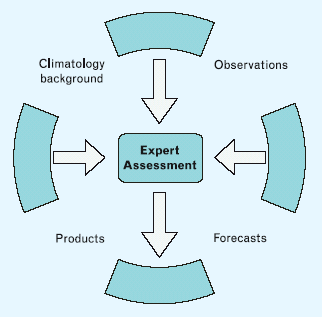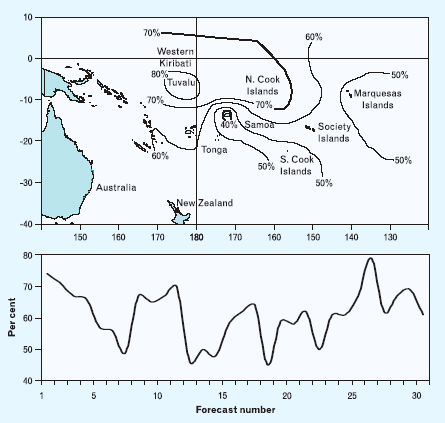Tiempo Climate Cyberlibrary
Island Climate Update
- Tiempo archive
- Complete issues
- Selected articles
- Cartoons
- Climate treaty
- Latest news
- Secretariat
- National reports
- IPCC
About the Cyberlibrary
The Tiempo Climate Cyberlibrary was developed by Mick Kelly and Sarah Granich on behalf of the Stockholm Environment Institute and the International Institute for Environment and Development, with sponsorship from the Swedish International Development Cooperation Agency.
While every effort is made to ensure that information on this site, and on other sites that are referenced here, is accurate, no liability for loss or damage resulting from use of this information can be accepted.
   |
Ashmita Gosai, Penehuro Lefale and Jim Salinger describe the content and application of a highly successful seasonal climate bulletin. Ashmita Gosai is a Climate Applications Scientist at the National Institute of Water and Atmospheric Research (NIWA) in Auckland, New Zealand. Penehuro Lefale is Pacific Island Analyst and at NIWA. Jim Salinger is a Senior Climate Scientist at NIWA. |
The Small Island Developing States (SIDS) in the South Pacific have long recognized that their social, cultural, environmental and economic well-being are solely dependent on their natural environments, which are largely driven by weather and climate.
While there are increasing concerns over the likely impacts of future anthropogenic climate change, the more immediate issues for Small Island Developing States emanate from natural weather and climate variability on the much shorter timescales of daily, seasonal and interannual. Extreme events, tropical cyclones, droughts and flooding, predominantly driven by the El Niño Southern Oscillation (ENSO) - El Niño and La Niña events - are classic examples.
According to the World Meteorological Organization, seventy per cent of natural disasters worldwide can be attributed to weather and climate. The paper, A needs analysis for the strengthening of Pacific Island Meteorological Services for the Australian Agency for International Development which was published by the South Pacific Regional Environment Programme in 2001, confirmed this assessment.
Recent statistical analyses of natural disasters show that over the past three decades, the proportion of the global population affected by weather and climate-related extremes and disasters has doubled. This rise was from roughly two per cent in 1975 to four per cent in 2001 as shown by Benito Müller in his paper Equity in Climate Change: The Great Divide, published by Oxford University in 2002 (www.oxfordclimatepolicy.org).
In absolute numbers, these trends have quadrupled over the same period rising from 70 to 250 million people. The Small Island Developing States of the South Pacific are strongly affected because of their geographical location which is frequently traversed by tropical cyclones, which are readily influenced by ENSO. Other research shows there is an increasing trend in climate extremes and variability in the Small Island Developing States of the South Pacific region.
It is imperative, therefore, that the Small Island Developing States of the South Pacific have access to accurate and timely climate forecasts to manage the risks associated with weather and climate extremes. The Island Climate Update (ICU) was conceived, after a ten-year consultation process involving these nations, climate research organizations, development partners and end-users, to address this need.
A virtual regional mechanism
The concept of a Small Island Developing States regional climate bulletin was first suggested in a study, The Changing Climate in Paradise: Feasibility Study on Climate Monitoring and Impacts in the Southwest Pacific, undertaken for the World Meteorological Organization in 1991. The concept was unanimously endorsed by the third annual South Pacific Regional Environment Programme’s Meeting of Regional Meteorological Services Directors held in Samoa in 1995.
It was recognized at the time that most of these small nation islands of the South Pacific, with the exception of the French and United States Territories, do not have the resources to develop locally their own global climate models. This, in turn, meant that they were unable to undertake analyses of climate information and products to be able to produce local climate forecasts.
The South Pacific Regional Environment Programme and the South Pacific Geo-Science Commission are the regional hosts for the Island Climate Update. Together with their development partners, the Italian Ministry for the Environment, the New Zealand Agency for International Development, climate research organizations and the National Meteorological Services of Small Island Developing States in the South Pacific, they form a virtual regional mechanism to produce the Island Climate Update. Our institute, The National Institute of Water and Atmospheric Research of New Zealand (NIWA), coordinates the scientific process involved in the Island Climate Update production.
Today, the Island Climate Update is a multinational monthly climate bulletin. Its primary goal is to assist Small Island Developing States of the South Pacific make informed planning and management decisions relating to climate sensitive sectors like agriculture, water, tourism, fisheries and energy through the provision of timely and accurate seasonal climate forecasts.
Putting it together - the process
The success of the Island Climate Update is solely dependent on the multinational collaboration amongst all the organizations and stakeholders involved. Figure 1 summarizes the main steps involved in preparing the bulletin.
|
|
Figure 1: Putting the Island Climate Update together |
The preparation of seasonal guidance materials such as observations and background climatology, are first circulated amongst the participating partners. This is followed by a monthly teleconference where the current and three monthly seasonal climate analyses (expert assessment), based on the seasonal guidance materials, are discussed. A consensus on the behaviour of the largescale climate patterns, such as and the South Pacific Convergence Zone, that affect the weather and climate of the Small Island Developing States region, is reached. This consensus forms the basis of the next threemonth climate outlook shown as Products and Forecasts in Figure 1.
A number of organizations and countries are involved in the monthly teleconference discussions:
- the Australian Bureau of Meteorology;
- Meteo-France (New Caledonia and French Polynesia);
- the Fiji Meteorological Service;
- the Samoa Meteorological Service;
- the US National Oceanic and Atmospheric Administration (NOAA);
- the National Weather Service;
- NOAA Climate Prediction Center; and,
- the International Research Institute for Climate Prediction.
The Island Climate Update teleconference commences with a climate synopsis of the previous month by all participants. This is encapsulated in the second page of the bulletin. The first page of the Island Climate Update provides a general climate summary of previous monthly conditions with seasonal climate outlooks for the next three months.
The next major task is the global climate diagnostics. This involves a thorough review process by climate scientists in the Small Island Developing States with essential input from internationally renowned climate scientists during the teleconference. This is a very important part of the whole discussion as there is a need for consensus on ENSO.
ENSO is an important climatic feature as it plays a principal role in the seasonal climate of the Pacific region. Furthermore, in recent years, ENSO has been recognized as a critical climate factor that modulates rainfall and tropical cyclones in the region. Therefore, consensus has to be reached to ensure timely disaster preparedness if there be a need. It is also extremely vital to ensure the various organizations reduce the chances of conflicting ENSO forecasts. This, in turn, reduces any untimely anxiety in the Pacific Island communities who rely largely on their knowledge of the climate for their subsistence crops and water supply.
Seasonal rainfall forecasts for Small Island Developing States in the South Pacific are achieved through an ensemble of global forecast models. Generally, NIWA, in New Zealand, produces the seasonal rainfall forecast through interpolation techniques of a number of global rainfall forecast models for twenty countries in the region. Rainfall forecasts are thoroughly discussed and the local island scientists use their vast resident climate experience to reach consensus on a seasonal rainfall forecast for their particular country. Normally, the regional scientists provide advice on the Small Island Developing States in the South Pacific who are not present in the teleconference.
During the tropical cyclone season which is from November to April, the Island Climate Update team also prepares a tropical cyclone outlook for the season based on the phase of ENSO, the Southwest Pacific sea surface temperatures and statistical tropical cyclone data. This is usually done at the beginning of the season, October or November. Many National Meteorological Services rely on the Island Climate Update’s tropical cyclone guidance to plan and prepare for cyclone related disasters. Once again, consensus is reached by the Island Climate Update team before the tropical cyclone outlook is released to the public.
|
“We in the Pacific have now come about to
realizing the potential usefulness and
appropriateness, especially in having a more
comprehensible and more knowledgeable tool (Island
Climate Update), of assisting our people plan and
prepare adequately for the months ahead. I commend
and congratulate the producers and contributors and
especially the donors for, without this financial
support, this most valuable and useful tool to the
Pacific Islands shall never come forth.” |
How accurate are the climate outlooks?
Seasonal climate outlooks should be verified to determine the skill of models and the forecasters. This is carried out at the start of the new month, prior to the teleconference. A number of Small Island Developing States and collaborating partners provide rainfall and temperature information for verification of past three-month outlooks. This group includes: Australia, the Cook Islands, Fiji, French Polynesia, Kiribati, New Caledonia, Niue, Papua New Guinea, Samoa, the Solomon Islands, Tokelau, Tonga, Tuvalu, Vanuatu, and Wallis and Futuna.
|
|
|
Figure 2: Frequency of correct 3-month rainfall outlooks (top panel), and validation scores for the 30 (3-month) rainfall outlooks (bottom panel). This shows the percentage correct forecasts. Scores of 60 per cent or more indicate significantly better outcomes than by chance |
Validation of the first thirty Island Climate Update outlooks for the Southwest Pacific (see Figure 2) indicates how often the forecasts have been correct in a categorical sense. Taking the Island Climate Update forecast category (below, average or below, average, average or above, or above average) to be assigned the highest probability, the contours and numbers show the percentage frequency of correct forecasts.
The hit rate has been highest (> 70 per cent) in the 0-20?S latitudes west of about 155°W, in the region from Western Kiribati to the Northern Cook Islands, including Tokelau, and especially over Tuvalu (81 per cent). The scores have, however, been much lower in areas around and to the south and east of Samoa. For the thirty issue period, the average hit rate for the whole of the forecast region has ranged between about 45 and 80 per cent (Figure 2). The distribution of forecast success is affected by some extent to the enso state and the location of the South Pacific Convergence Zone. With much of the period being above 50 per cent, a useful skill has been achieved.
Conclusions
Accurate seasonal to interannual climate prediction has been a major research and application topic for the Small Island Developing States in the South Pacific. The experience so far from the Island Climate Update has demonstrated unequivocally that shortrange climate prediction is achievable with skill.
Through the provision of such accurate and timely seasonal climate outlooks the small island nations of the South Pacific are becoming increasingly aware of the value of climate predictions. In some of these nations, they are using the outlooks from the Island Climate Update to formulate appropriate response strategies to impending climate events such as tropical cyclones and other climate-related impacts.
The success of the Island Climate Update to date, however, has been solely dependent on the multi-national collaboration by all participating partners. This has been facilitated especially through access to historical and real time climate data and expert advice from the Small Island Developing States of the South Pacific. This dataset is used for climate forecast validation and improving future seasonal forecasts.
The continued success of the Island Climate Update is ultimately attributable to the wide multilateral cooperation and commitment of many nations and organizations. As a result, the Island Climate Update has succeeded in delivering scientifically sound climate information and products to the Small Island Developing States of the South Pacific in a cost effective manner.
Further information
Ashmita Gosai, Penehuro Lefale and Jim Salinger, National
Institute of Water and Atmospheric Research Ltd, PO Box
109695, Auckland, New Zealand. Fax: +64-9-3752051. Email:
a.gosai@niwa.co.nz;
p.lefale@niwa.co.nz;
j.salinger@niwa.co.nz.
Web: www.niwa.co.nz.
On the Web
A list of sites providing monitoring
and forecast information related to the ENSO phenomenon
is available in the Tiempo Climate Cyberlibrary. The
Island Climate
Update is available in electronic format.
Bright Ideas

General Electric plans to cut solar installation costs by half

Project 90 by 2030 supports South African school children and managers reduce their carbon footprint through its Club programme

Bath & North East Somerset Council in the United Kingdom has installed smart LED carriageway lighting that automatically adjusts to light and traffic levels

The United States National Oceanic and Atmospheric Administration and the American Public Gardens Association are mounting an educational exhibit at Longwood Gardens showing the link between temperature and planting zones

The energy-efficient Crowne Plaza Copenhagen Towers hotel is powered by renewable and sustainable sources, including integrated solar photovoltaics and guest-powered bicycles
El Hierro, one of the Canary Islands, plans to generate 80 per cent of its energy from renewable sources

The green roof on the Remarkables Primary School in New Zealand reduces stormwater runoff, provides insulation and doubles as an outdoor classroom

The Weather Info for All project aims to roll out up to five thousand automatic weather observation stations throughout Africa

SolSource turns its own waste heat into electricity or stores it in thermal fabrics, harnessing the sun's energy for cooking and electricity for low-income families

The Wave House uses vegetation for its architectural and environmental qualities, and especially in terms of thermal insulation

The Mbale compost-processing plant in Uganda produces cheaper fertilizer and reduces greenhouse gas emissions

At Casa Grande, Frito-Lay has reduced energy consumption by nearly a fifth since 2006 by, amongst other things, installing a heat recovery system to preheat cooking oil
Updated: May 15th 2015

